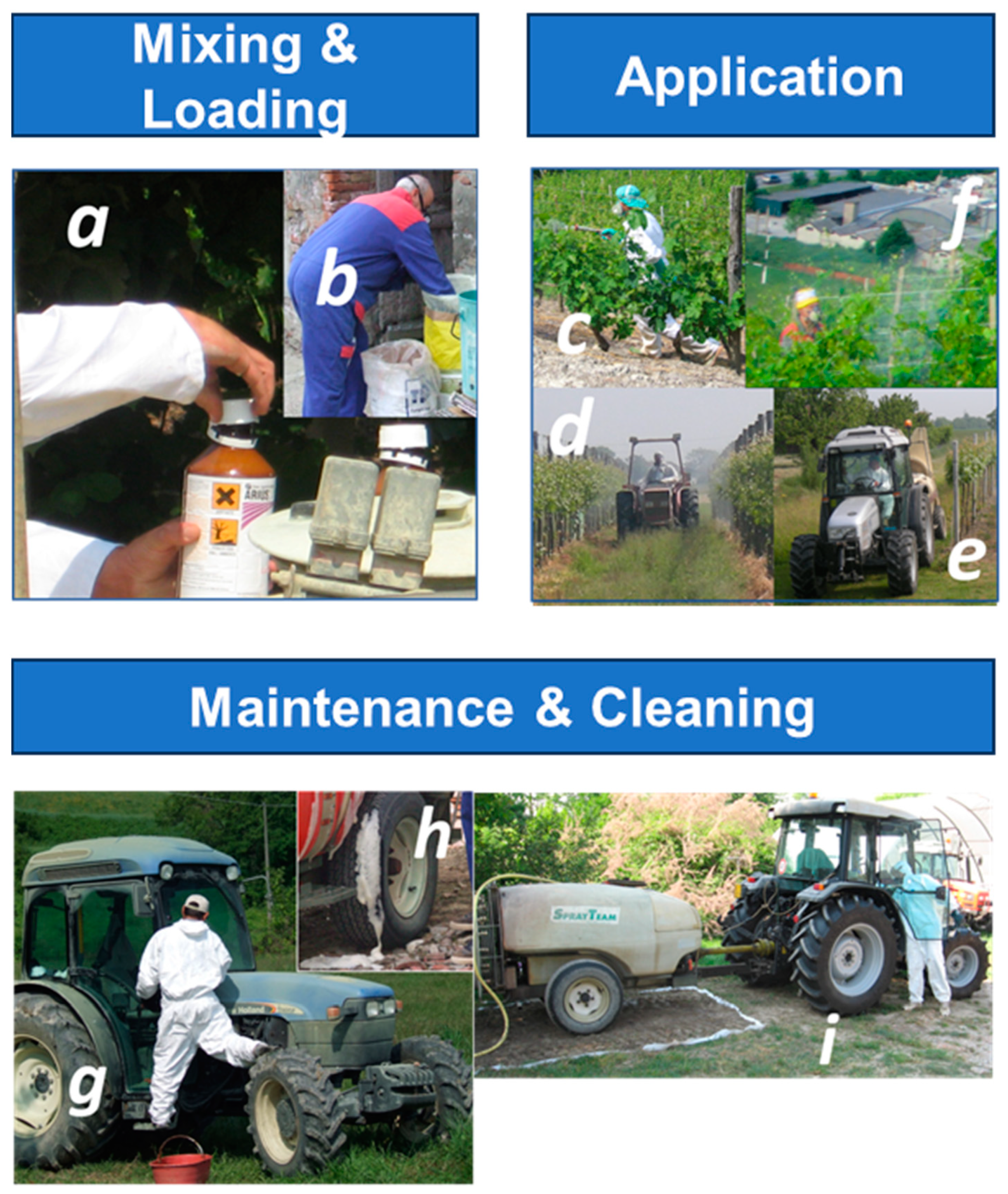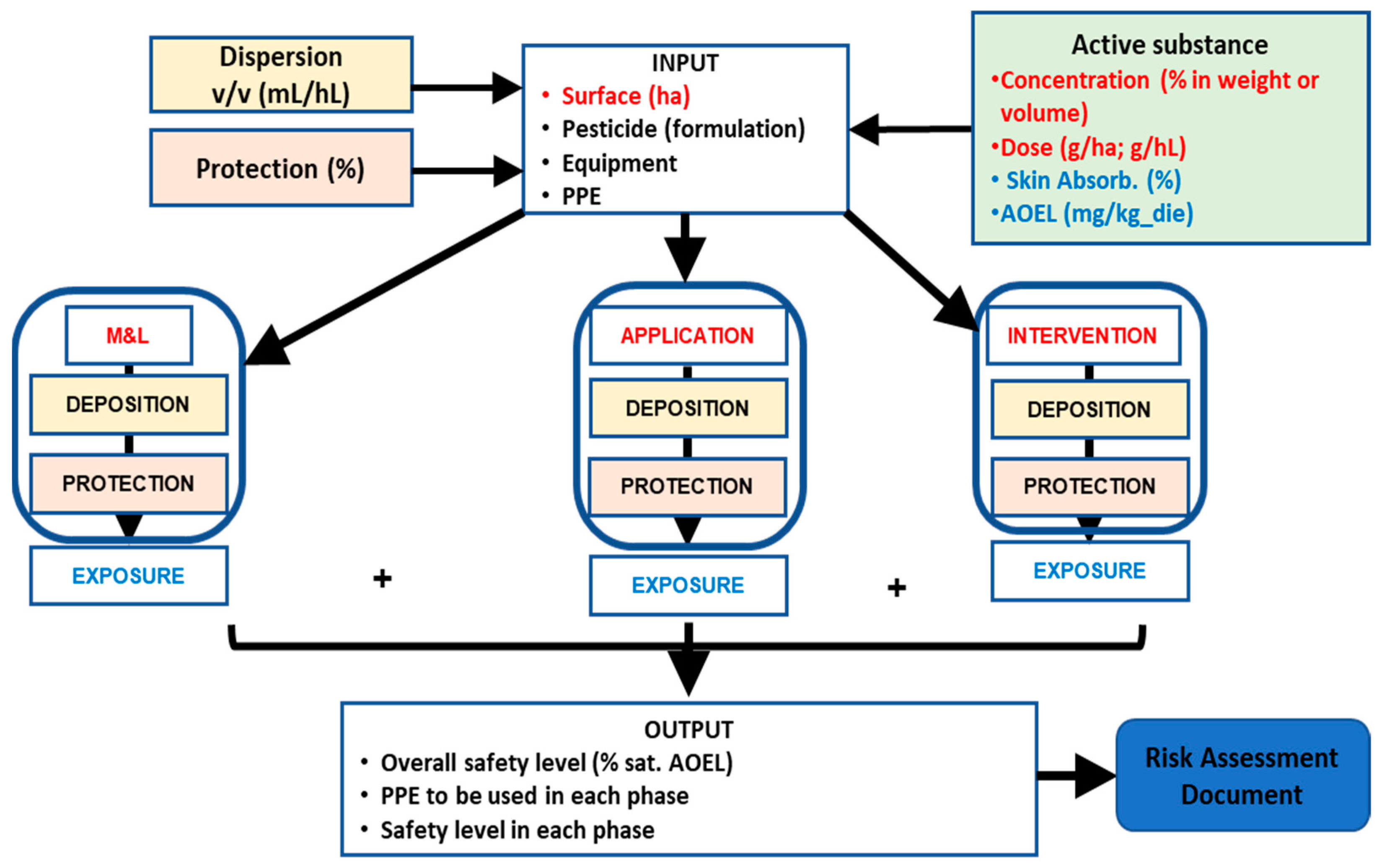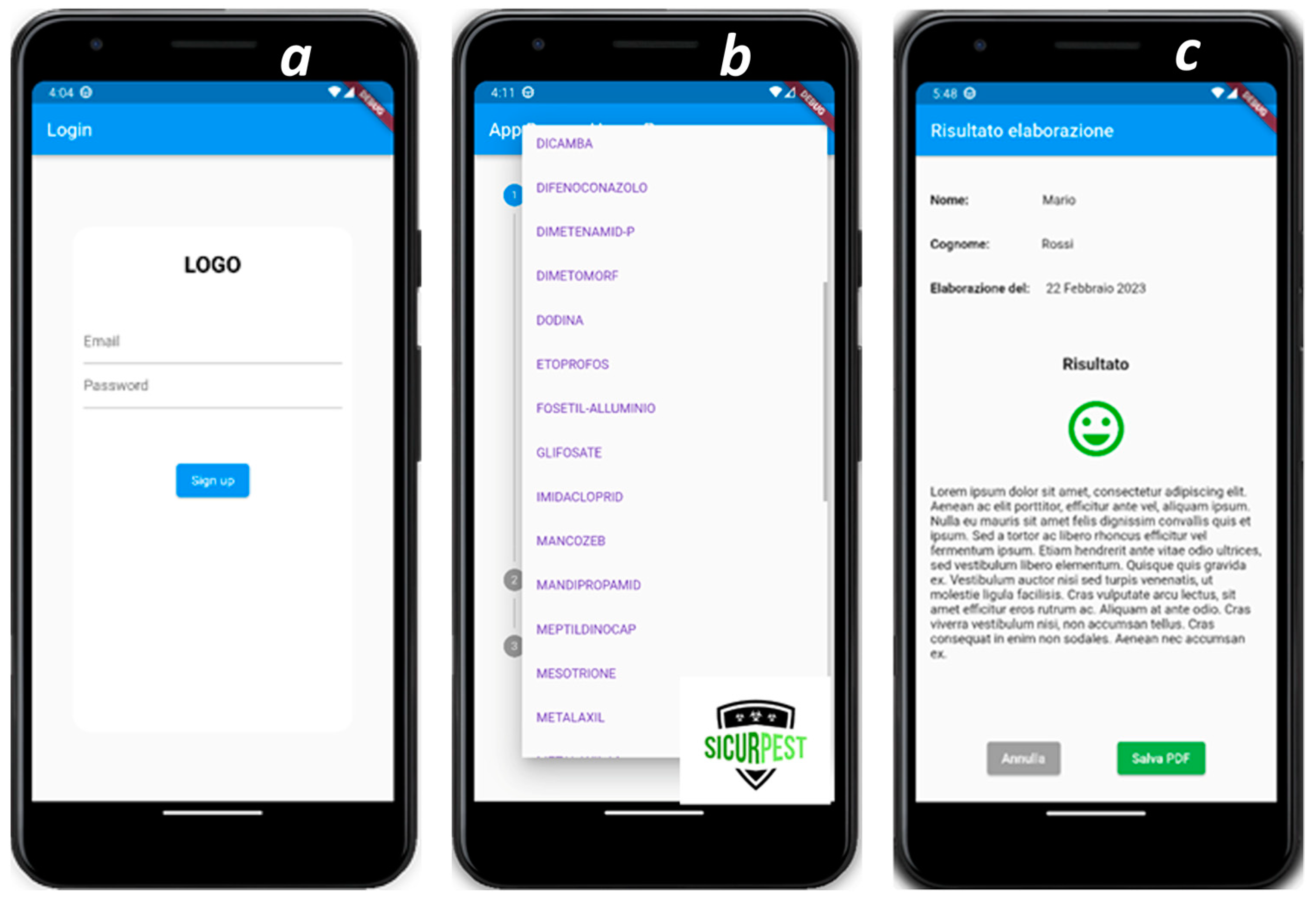Sicurpest: A Prototype of a User-Friendly Tool for Preventive Risk Assessment of Pesticide Use in Agriculture
Abstract
1. Introduction
1.1. Problem Overview
1.2. Pesticide Use Risk Assessment
1.3. Research Background
2. Materials and Methods
- Data collection on the typical levels of exposure in different risk and exposure scenarios;
- Definition of the numerical relationships between different determinants of exposure;
- Creation of the model through adequate algorithms.
2.1. Data Collection of Typical Levels of Exposure in Different Application Scenarios
2.2. Definition of the Relationships Between Different Determinants of Exposure in the Main Phases of Work with Pesticides
- Extension of the treated area;
- Type of crop: low and high;
- Application modalities: knapsacks (manual and motorized), tractor sprayer, application bar, application pressure;
- Type of tractor: open, closed, closed and equipped with charcoal filters.
2.3. Phytoiatric and Safety Profile of the Pesticides Used in Italy
2.4. Construction of a Physically Based Model and Related Algorithms
3. Results
3.1. Risk Assessment Model
3.2. Description of the Software Tool (Sicurpest, Italian Edition)
- Type of crop;
- Type of pest (Figure 3b);
- Treated surface (ha);
- Active ingredient used (commercial name);
- Physical Form of product (powder; liquid; granules);
- Active ingredient’s concentration.
- Face;
- Head;
- Hands;
- Body;
- Feet.
- Volume of applied solution per surface (hL/ha);
- Volume of the tank (liters);
- Spraying pressure (bar);
- Type of spraying equipment (handheld; tractor-different kinds).
3.3. Application in Olive Culture: Fighting Infestation from the Olive Mosquito Bactrocera Oleae
4. Discussion
5. Conclusions
Supplementary Materials
Author Contributions
Funding
Institutional Review Board Statement
Informed Consent Statement
Data Availability Statement
Acknowledgments
Conflicts of Interest
References
- European Risk Observatory (ERO). Review of the Future of Agriculture and Occupational Safety and Health (OSH). Foresight on New and Emerging Risks in OSH. European Agency for Safety and Health at Work. 2020. Available online: https://op.europa.eu/en/publication-detail/-/publication/2f4a9f86-604d-11eb-8146-01aa75ed71a1/language-en (accessed on 1 October 2024).
- Kim, H.; Lee, K.; Räsänen, K. Agricultural injuries in Korea and errors in systems of safety. Ann. Agric. Environ. Med. 2016, 23, 432–436. [Google Scholar] [CrossRef]
- Fargnoli, M.; Lombardi, M.; Haber, N. A fuzzy-QFD approach for the enhancement of work equipment safety: A case study in the agriculture sector. Int. J. Reliab. Saf. 2018, 12, 306–326. [Google Scholar] [CrossRef]
- Qi, X.; Yao, X.; Cong, X.; Li, S.; Han, M.; Tao, Z.; Yang, X.; Qi, X.; Shi, F.; Wang, S. Profile and risk factors in farmer injuries: A review based on Haddon matrix and 5 E’s risk reduction strategy. Front. Public Health 2024, 12, 1322884. [Google Scholar] [CrossRef]
- Damalas, C.A.; Koutroubas, S.D. Farmers’ Exposure to Pesticides: Toxicity Types and Ways of Prevention. Toxics 2016, 4, 1. [Google Scholar] [CrossRef] [PubMed]
- Rani, L.; Thapa, K.; Kanojia, N.; Sharma, N.; Singh, S.; Grewal, A.S.; Srivastav, A.L.; Kaushal, J. An extensive review on the consequences of chemical pesticides on human health and environment. J. Clean. Prod. 2021, 283, 124657. [Google Scholar] [CrossRef]
- Boyd, C.E.; Massaut, L. Risks associated with the use of chemicals in pond aquaculture. Aquac. Eng. 1999, 20, 113–132. [Google Scholar] [CrossRef]
- Rajmohan, K.S.; Chandrasekaran, R.; Varjani, S. A Review on Occurrence of Pesticides in Environment and Current Technologies for Their Remediation and Management. Indian J. Microbiol. 2020, 60, 125–138. [Google Scholar] [CrossRef]
- Ahmad, F.; Ahmad, F.A.; Alsayegh, A.A.; Zeyaullah, M.; AlShahrani, A.M.; Muzammil, K.; Saati, A.A.; Wahab, S.; Elbendary, E.Y.; Kambal, N.; et al. Pesticides impacts on human health and the environment with their mechanisms of action and possible countermeasures. Heliyon 2024, 10, e29128. [Google Scholar]
- Moreira, A.; da Silva, M.V. Pesticide Application as a Risk Factor/Behaviour for Workers’ Health: A Systematic Review. Environments 2023, 10, 160. [Google Scholar] [CrossRef]
- Damalas, C.A.; Eleftherohorinos, I.G. Pesticide Exposure, Safety Issues, and Risk Assessment Indicators. Int. J. Environ. Res. Public Health 2011, 8, 1402–1419. [Google Scholar] [CrossRef]
- Burns, C.J.; Mahlburg, W.M.; Dutra, J. Pesticide exposure among farm workers. Environ. Res. 2007, 105, 285–288. [Google Scholar] [CrossRef]
- Khan, M.; Damalas, C.A. Occupational exposure to pesticides and resultant health problems among cotton farmers of Punjab, Pakistan. Int. J. Environ. Health Res. 2015, 25, 508–521. [Google Scholar] [CrossRef]
- Keleb, A.; Ademas, A.; Abebe, M.; Berihun, G.; Desye, B.; Bezie, A.E. Knowledge of health risks, safety practices, acute pesticide poisoning, and associated factors among farmers in rural irrigation areas of northeastern Ethiopia. Front. Public Health 2024, 12, 1474487. [Google Scholar] [CrossRef]
- Manno, M.; Viau, C.; Cocker, J.; Colosio, C.; Lowry, L.; Mutti, A.; Nordberg, M.; Wang, S. Biomonitoring for occupational health risk assessment (BOHRA). Toxicol. Lett. 2010, 192, 3–16. [Google Scholar] [CrossRef] [PubMed]
- Maroni, M.; Fanetti, A.C.; Metruccio, F. Risk assessment and management of occupational exposure to pesticides in agriculture. Med. Lav. 2006, 97, 430–437. [Google Scholar] [PubMed]
- Machado, S.C.; Martins, I. Risk assessment of occupational pesticide exposure: Use of endpoints and surrogates. Regul. Toxicol. Pharmacol. 2018, 98, 276–283. [Google Scholar] [CrossRef] [PubMed]
- Fargnoli, M.; Lombardi, M.; Puri, D.; Casorri, L.; Masciarelli, E.; Mandić-Rajčević, S.; Colosio, C. The Safe Use of Pesticides: A Risk Assessment Procedure for the Enhancement of Occupational Health and Safety (OHS) Management. Int. J. Environ. Res. Public Health 2019, 16, 310. [Google Scholar] [CrossRef]
- Abbassy, M.M.S. Farmer’s Knowledge, Attitudes and Practices, and their Exposure to Pesticide Residues after Application on the Vegetable and Fruit Crops. Case Study: North of Delta, Egypt. J. Environ. Anal. Toxicol. 2017, 7, 510. [Google Scholar] [CrossRef]
- Fargnoli, M.; Lombardi, M. NOSACQ-50 for Safety Climate Assessment in Agricultural Activities: A Case Study in Central Italy. Int. J. Environ. Res. Public Health 2020, 17, 9177. [Google Scholar] [CrossRef]
- Cecchini, M.; Colantoni, A.; Monarca, D.; Cossio, F.; Riccioni, S. Survey on the status of enforcement of european directives on health and safety at work in some farms of central italy. Chem. Eng. Trans. 2017, 58, 103–108. [Google Scholar] [CrossRef]
- EFSA (European Food Safety Authority). Guidance for the Assessment of Exposure of Operators, Workers, Residents and Bystanders in Risk Assessment of Plant Protection Products. 2022. Available online: https://www.efsa.europa.eu/en/efsajournal/pub/7032 (accessed on 4 November 2024).
- Abukari, W. Pesticides applicator exposure assessment: A comparison between modeling and actual measurement. J. Environ. Earth Sci. 2015, 5, 101–115. [Google Scholar]
- Mattioli, S.; Gori, D.; Di Gregori, V.; Ricotta, L.; Baldasseroni, A.; Farioli, A.; Zanardi, F.; Galletti, S.; Colosio, C.; Curti, S.; et al. PubMed search strings for the study of agricultural workers’ diseases. Am. J. Ind. Med. 2013, 56, 1473–1481. [Google Scholar] [CrossRef] [PubMed]
- Mandic-Rajcevic, S.; Rubino, F.M.; Ariano, E.; Cottica, D.; Neri, S.; Colosio, C. Environmental and biological monitoring for the identification of main exposure determinants in vineyard mancozeb applicators. J. Expo. Sci. Environ. Epidemiol. 2018, 28, 289–296. [Google Scholar] [CrossRef] [PubMed]
- Aprea, C.; Colosio, C.; Mammone, T.; Minoia, C.; Maroni, M. Biological monitoring of pesticide exposure: A review of analytical methods. J. Chromatogr. B Analyt. Technol. Biomed. Life Sci. 2002, 769, 191–219. [Google Scholar] [CrossRef] [PubMed]
- Mercadante, R.; Polledri, E.; Rubino, F.M.; Mandic-Rajcevic, S.; Vaiani, A.; Colosio, C.; Moretto, A.; Fustinoni, S. Assessment of penconazole exposure in winegrowers using urinary biomarkers. Environ. Res. 2019, 168, 54–61. [Google Scholar] [CrossRef]
- Mandic-Rajcevic, S.; Rubino, F.M.; Ariano, E.; Cottica, D.; Negri, S.; Colosio, C. Exposure duration and absorbed dose assessment in pesticide-exposed agricultural workers: Implications for risk assessment and modeling. Int. J. Hyg. Environ. Health 2019, 222, 494–502. [Google Scholar] [CrossRef] [PubMed]
- Mandić-Rajčević, S.; Rubino, F.M.; Colosio, C. Establishing health-based biological exposure limits for pesticides: A proof of principle study using mancozeb. Regul. Toxicol. Pharmacol. 2020, 115, 104689. [Google Scholar] [CrossRef] [PubMed]
- Colosio, C.; Visentin, S.; Birindelli, S.; Campo, L.; Fustinoni, S.; Mariani, F.; Tiramani, M.; Tommasini, M.; Brambilla, G.; Maroni, M. Reference values for ethylenethiourea in urine in Northern Italy: Results of a pilot study. Toxicol. Lett. 2006, 162, 153–157. [Google Scholar] [CrossRef] [PubMed]
- Porru, S.; Ferrian, M.; Mastrangelo, G.; Capovilla, D.; Corsini, E.; Fustinoni, S.; Peruzzi, M.; Colosio, C. Short occupational exposure to glyphosate and its biomonitoring via urinary levels of glyphosate and metabolite AMPA (Amino-MethylPhosphonic acid), in Italian vineyard workers. Heliyon 2024, 10, e36407. [Google Scholar] [CrossRef] [PubMed] [PubMed Central]
- Colosio, C.; Angotzi, G.; Ariano, E.; Borghesi, S.; Bovenzi, M.; De Vito, G.; Gerardi, D.; Gobba, F.; L’Abbate, N.; Lucchini, R.; et al. Chap. 4. Health risks in agriculture and their assessment. Chemical risk. In Guidelines for the Health Surveillance in Agriculture; SIMLII; Cortesi, I., Ed.; Nuova Editrice Berti: Parma, Italy, 2013; ISBN 978-88-7364-613-6. (In Italian) [Google Scholar]
- Baldi, I.; Lebailly, P.; Rondeau, V.; Bouchart, V.; Blanc-Lapierre, A.; Bouvier, G.; Canal-Raffin, M.; Garrigou, A. Levels and determinants of pesticide exposure in operators involved in treatment of vineyards: Results of the PESTEXPO Study. J. Expo. Sci. Environ. Epidemiol. 2012, 22, 593–600. [Google Scholar] [CrossRef]
- Fustinoni, S.; Mercadante, R.; Polledri, E.; Rubino, F.M.; Mandic-Rajcevic, S.; Vianello, G.; Colosio, C.; Moretto, A. Biological monitoring of exposure to tebuconazole in winegrowers. J. Expo Sci. Environ. Epidemiol. 2014, 24, 643–649. [Google Scholar] [CrossRef] [PubMed]
- Mandic-Rajcevic, S.; Rubino, F.M.; Vianello, G.; Fugnoli, L.; Polledri, E.; Mercadante, R.; Moretto, A.; Fustinoni, S.; Colosio, C. Dermal exposure and risk assessment of tebuconazole applicators in vineyards. Med. Lav. 2015, 106, 294–315. [Google Scholar] [PubMed]
- Tudi, M.; Li, H.; Li, H.; Wang, L.; Lyu, J.; Yang, L.; Tong, S.; Yu, Q.J.; Ruan, H.D.; Atabila, A.; et al. Exposure Routes and Health Risks Associated with Pesticide Application. Toxics 2022, 10, 335. [Google Scholar] [CrossRef]
- Teklu, B.M.; Yakan, S.D.; Brink, P.J.V.D. The use of a simple model for the regulatory environmental risk assessment of pesticides in Ethiopia. Chemosphere 2023, 316, 137794. [Google Scholar] [CrossRef]
- Damalas, C.A.; Koutroubas, S.D. Farmers’ Training on Pesticide Use Is Associated with Elevated Safety Behavior. Toxics 2017, 5, 19. [Google Scholar] [CrossRef] [PubMed]
- Aprea, C.; Terenzoni, B.; De Angelis, V.; Sciarra, G.; Lunghini, L.; Borzacchi, G.; Vasconi, D.; Fani, D.; Quercia, A.; Salvan, A.; et al. Evaluation of Skin and Respiratory Doses and Urinary Excretion of Alkylphosphates in Workers Exposed to Dimethoate During Treatment of Olive Trees. Arch. Environ. Contam. Toxicol. 2005, 48, 127–134. [Google Scholar] [CrossRef]
- Ramwell, C.T.; Johnson, P.D.; Boxall, A.B.; Rimmer, D.A. Pesticide residues on the external surfaces of field crop sprayers: Occupational exposure. Ann. Occup. Hyg. 2005, 49, 345–350. [Google Scholar]
- Gustin, C.A.; Moran, S.J.; Fuhrman, J.D.; Kurtzweil, M.L.; Kronenberg, J.M.; Gustafson, D.I.; Marshall, M.A. Applicator exposure to acetochlor based on biomonitoring. Regul. Toxicol. Pharmacol. 2005, 43, 141–149. [Google Scholar] [CrossRef]
- Gerritsen-Ebben, M.G.; Brouwer, D.H.; Van Hemmen, J.J. Personal protective equipment for registration purposes of pesticides. Commun. Agric. Appl. Biol. Sci. 2007, 72, 87–93. [Google Scholar]
- Lebailly, P.; Bouchart, V.; Baldi, I.; Lecluse, Y.; Heutte, N.; Gislard, A.; Malas, J.-P. Exposure to Pesticides in Open-field Farming in France. Ann. Occup. Hyg. 2009, 53, 69–81. [Google Scholar] [CrossRef]
- Machera, K.; Tsakirakis, A.; Charistou, A.; Anastasiadou, P.; Glass, C.R. Dermal Exposure of Pesticide Applicators as a Measure of Coverall Performance Under Field Conditions. Ann. Occup. Hyg. 2009, 53, 573–584. [Google Scholar] [CrossRef] [PubMed]
- Basilicata, P.; Simonelli, A.; Silvestre, A.; Lamberti, M.; Pedata, P.; Feola, D.; Acampora, A.; Pieri, M.; Sannolo, N.; Miraglia, N. Evaluation by Environmental Monitoring of Pesticide Absorption in Farm Workers of 18 Italian Tomato Cultivations. Int. J. Immunopathol. Pharmacol. 2013, 26, 517–523. [Google Scholar] [CrossRef]
- Tsakirakis, A.N.; Kasiotis, K.M.; Charistou, A.N.; Arapaki, N.; Tsatsakis, A.; Tsakalof, A.; Machera, K. Dermal & inhalation exposure of operators during fungicide application in vineyards. Evaluation of coverall performance. Sci. Total. Environ. 2014, 470, 282–289. [Google Scholar] [CrossRef]
- Aprea, M.C.; Bosi, A.; Manara, M.; Mazzocchi, B.; Pompini, A.; Sormani, F.; Lunghini, L.; Sciarra, G. Assessment of exposure to pesticides during mixing/loading and spraying of tomatoes in the open field. J. Occup. Environ. Hyg. 2016, 13, 476–489. [Google Scholar] [CrossRef] [PubMed]
- Thouvenin, I.; Bouneb, F.; Mercier, T. Operator dermal exposure and protection provided by personal protective equipment and working coveralls during mixing/loading, application and sprayer cleaning in vineyards. Int. J. Occup. Saf. Ergon. 2017, 23, 229–239. [Google Scholar] [CrossRef]
- Wong, H.L.; Garthwaite, D.G.; Ramwell, C.T.; Brown, C.D. Assessment of exposure of professional agricultural operators to pesticides. Sci. Total. Environ. 2018, 619, 874–882. [Google Scholar] [CrossRef]
- Baldi, I.; Lebailly, P.; Jean, S.; Rougetet, L.; Dulaurent, S.; Marquet, P. Pesticide contamination of workers in vineyards in France. J. Expo. Sci. Environ. Epidemiol. 2006, 16, 115–124. [Google Scholar] [CrossRef] [PubMed]



| Parameters | Values | Unit | Source |
|---|---|---|---|
| Name | KILLER | Product label | |
| Type | powder | Product label | |
| GAP | 100 | g/ha_form | Product label |
| active_subst | ACTIVOL | Product label | |
| Concentration | 50 | g/100 g | Product label |
| AOEL | 0.05 | mg/kg_BW | database |
| assorb_skin | 5 | % | database |
| Exposure | 30% | 45% | 70% | 90% | |
|---|---|---|---|---|---|
| Formulation | Concentration Dispersion (%) | <30% | 30–60% | 60–80% | >80% |
| Soluble bags | 0% | 0% | 0% | 0% | 0% |
| Liquid concentrate | 0.10% | 0.030% | 0.045% | 0.070% | 0.090% |
| Powder | 0.01% | 0.003% | 0.005% | 0.007% | 0.009% |
| Clothing Type | Deposition Factor ppm 2 |
|---|---|
| Backpack | 1000 |
| Towed pipe (manual) | 100 |
| Tractor (open cockpit) with towed tank | 10 |
| Tractor (closed cockpit, natural ventilation) with towed tank | 1 |
| Tractor (closed cockpit, forced ventilation) with towed tank | 0.1 |
| Tractor (closed cockpit, forced ventilation, charcoal-filtered air) with towed tank | 99% |
| Clothing Type | Protection Factor 2 |
|---|---|
| Underwear | 50% |
| Generic clothes | 70% |
| Cotton coverall (reusable) | 90% |
| Non-woven fabric single-use coverall | 90% |
| HazMat disposable coverall | 99% |
Disclaimer/Publisher’s Note: The statements, opinions and data contained in all publications are solely those of the individual author(s) and contributor(s) and not of MDPI and/or the editor(s). MDPI and/or the editor(s) disclaim responsibility for any injury to people or property resulting from any ideas, methods, instructions or products referred to in the content. |
© 2025 by the authors. Licensee MDPI, Basel, Switzerland. This article is an open access article distributed under the terms and conditions of the Creative Commons Attribution (CC BY) license (https://creativecommons.org/licenses/by/4.0/).
Share and Cite
Rubino, F.M.; Puri, D.; Fargnoli, M.; Lombardi, M.; Mandić-Rajčević, S.; Colosio, C. Sicurpest: A Prototype of a User-Friendly Tool for Preventive Risk Assessment of Pesticide Use in Agriculture. Toxics 2025, 13, 89. https://doi.org/10.3390/toxics13020089
Rubino FM, Puri D, Fargnoli M, Lombardi M, Mandić-Rajčević S, Colosio C. Sicurpest: A Prototype of a User-Friendly Tool for Preventive Risk Assessment of Pesticide Use in Agriculture. Toxics. 2025; 13(2):89. https://doi.org/10.3390/toxics13020089
Chicago/Turabian StyleRubino, Federico Maria, Daniele Puri, Mario Fargnoli, Mara Lombardi, Stefan Mandić-Rajčević, and Claudio Colosio. 2025. "Sicurpest: A Prototype of a User-Friendly Tool for Preventive Risk Assessment of Pesticide Use in Agriculture" Toxics 13, no. 2: 89. https://doi.org/10.3390/toxics13020089
APA StyleRubino, F. M., Puri, D., Fargnoli, M., Lombardi, M., Mandić-Rajčević, S., & Colosio, C. (2025). Sicurpest: A Prototype of a User-Friendly Tool for Preventive Risk Assessment of Pesticide Use in Agriculture. Toxics, 13(2), 89. https://doi.org/10.3390/toxics13020089










